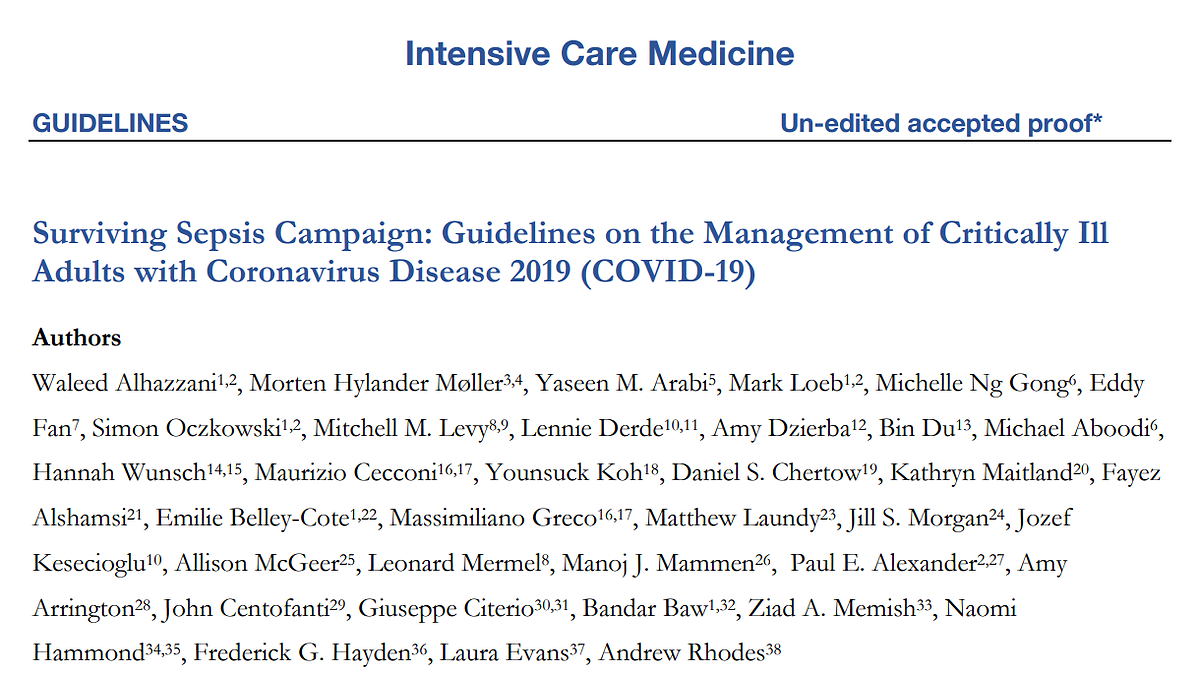Recommendation:
- For healthcare workers performing aerosol-generating procedures* on patients with COVID-19 in the ICU, we recommend using fitted respirator masks (N95 respirators, FFP2, or equivalent), as opposed to surgical/medical masks, in addition to other personal protective equipment (i.e., gloves, gown, and eye protection, such as a face shield or safety goggles) (best practice statement). * Aerosol-generating procedures in the ICU include: endotracheal intubation, bronchoscopy, open suctioning, administration of nebulized treatment, manual ventilation before intubation, physical proning of the patient, disconnecting the patient from the ventilator, non-invasive positive pressure ventilation, tracheostomy, and cardiopulmonary resuscitation
- We recommend performing aerosol-generating procedures on ICU patients with COVID-19 in a negative pressure room (best practice statement).
- For healthcare workers providing usual care for non-ventilated COVID-19 patients, we suggest using surgical/medical masks, as opposed to respirator masks, in addition to other personal protective equipment (i.e., gloves, gown, and eye protection, such as a face shield or safety goggles) (weak recommendation, low quality evidence).
- For healthcare workers who are performing non-aerosol-generating procedures on mechanically ventilated (closed circuit) patients with COVID-19, we suggest using surgical/medical masks, as opposed to respirator masks, in addition to other personal protective equipment (i.e., gloves, gown, and eye protection, such as a face shield or safety goggles) (weak recommendation, low quality evidence).
- For healthcare workers performing endotracheal intubation on patients with COVID-19, we suggest using video-guided laryngoscopy, over direct laryngoscopy, if available (weak recommendation, low quality evidence).
- For COVID-19 patients requiring endotracheal intubation, we recommend that endotracheal intubation be performed by the healthcare worker who is most experienced with airway management in order to minimize the number of attempts and risk of transmission (best practice statement).
- For intubated and mechanically ventilated adults with suspicion of COVID-19:
- For diagnostic testing, we suggest obtaining lower respiratory tract samples in preference to upper respiratory tract (nasopharyngeal or oropharyngeal) samples (weak recommendation, low quality evidence).
- With regard to lower respiratory samples, we suggest obtaining endotracheal aspirates in preference to bronchial wash or bronchoalveolar lavage samples (weak recommendation, low quality evidence).
- In adults with COVID-19 and shock, we suggest using dynamic parameters skin temperature, capillary refilling time, and/or serum lactate measurement over static parameters in order to assess fluid responsiveness (weak recommendation, low quality evidence).
- For the acute resuscitation of adults with COVID-19 and shock, we suggest using a conservative over a liberal fluid strategy (weak recommendation, very low quality evidence).
- For the acute resuscitation of adults with COVID-19 and shock, we recommend using crystalloids over colloids (strong recommendation, moderate quality evidence).
- For the acute resuscitation of adults with COVID-19 and shock, we suggest using buffered/balanced crystalloids over unbalanced crystalloids (weak recommendation, moderate quality evidence).
- For the acute resuscitation of adults with COVID-19 and shock, we recommend against using hydroxyethyl starches (strong recommendation, moderate quality evidence).
- For the acute resuscitation of adults with COVID-19 and shock, we suggest against using gelatins (weak recommendation, low quality evidence).
- For the acute resuscitation of adults with COVID-19 and shock, we suggest against using dextrans (weak recommendation, low quality evidence).
- For the acute resuscitation of adults with COVID-19 and shock, we suggest against the routine use of albumin for initial resuscitation (weak recommendation, moderate quality evidence).
- For adults with COVID-19 and shock, we suggest using norepinephrine as the first-line vasoactive agent, over other agents (weak recommendation, low quality evidence).
- If norepinephrine is not available, we suggest using either vasopressin or epinephrine as the first-line vasoactive agent, over other vasoactive agents, for adults with COVID-19 and shock (weak recommendation, low quality evidence).
- For adults with COVID-19 and shock, we recommend against using dopamine if norepinephrine is available (strong recommendation, high quality evidence).
- For adults with COVID-19 and shock, we suggest adding vasopressin as a second-line agent, over titrating norepinephrine dose, if target mean arterial pressure (MAP) cannot be achieved by norepinephrine alone (weak recommendation, moderate quality evidence).
- For adults with COVID-19 and shock, we suggest titrating vasoactive agents to target a MAP of 60-65 mmHg, rather than higher MAP targets (weak recommendation, low quality evidence).
- For adults with COVID-19 and shock with evidence of cardiac dysfunction and persistent hypoperfusion despite fluid resuscitation and norepinephrine, we suggest adding dobutamine, over increasing norepinephrine dose (weak recommendation, very low quality evidence).
- For adults with COVID-19 and refractory shock, we suggest using low-dose corticosteroid therapy (“shock-reversal”), over no corticosteroid therapy (weak recommendation, low quality evidence). Remark: A typical corticosteroid regimen in septic shock is intravenous hydrocortisone 200 mg per day administered either as an infusion or intermittent doses.
- In adults with COVID-19, we suggest starting supplemental oxygen if the peripheral oxygen saturation (SPO2) is < 92% (weak recommendation, low quality evidence), and recommend starting supplemental oxygen if SPO2 is < 90% (strong recommendation, moderate quality evidence).
- In adults with COVID-19 and acute hypoxemic respiratory failure on oxygen, we recommend that SPO2 be maintained no higher than 96% (strong recommendation, moderate quality evidence).
- For adults with COVID-19 and acute hypoxemic respiratory failure despite conventional oxygen therapy, we suggest using HFNC over conventional oxygen therapy (weak recommendation, low quality evidence).
- In adults with COVID-19 and acute hypoxemic respiratory failure, we suggest using HFNC over NIPPV (weak recommendation, low quality evidence).
- In adults with COVID-19 and acute hypoxemic respiratory failure, if HFNC is not available and there is no urgent indication for endotracheal intubation, we suggest a trial of NIPPV with close monitoring and short-interval assessment for worsening of respiratory failure (weak recommendation, very lowquality evidence).
- We were not able to make a recommendation regarding the use of helmet NIPPV compared with mask NIPPV. It is an option, but we are not certain about its safety or efficacy in COVID-19.
- In adults with COVID-19 receiving NIPPV or HFNC, we recommend close monitoring for worsening of respiratory status, and early intubation in a controlled setting if worsening occurs (best practice statement).
- In mechanically ventilated adults with COVID-19 and ARDS, we recommend using low tidal volume (Vt) ventilation (Vt 4-8 mL/kg of predicted body weight), over higher tidal volumes (Vt>8 mL/kg) (strong recommendation, moderate quality evidence).
- For mechanically ventilated adults with COVID-19 and ARDS, we recommend targeting plateau pressures (Pplat) of < 30 cm H2O (strong recommendation, moderate quality evidence).
- For mechanically ventilated adults with COVID-19 and moderate to severe ARDS, we suggest using a higher PEEP strategy, over a lower PEEP strategy (weak recommendation, low quality evidence). Remarks: If using a higher PEEP strategy (i.e., PEEP > 10 cm H2O), clinicians should monitor patients for barotrauma.
- For mechanically ventilated adults with COVID-19 and ARDS, we suggest using a conservative fluid strategy over a liberal fluid strategy (weak recommendation, low quality evidence).
- For mechanically ventilated adults with COVID-19 and moderate to severe ARDS, we suggest prone ventilation for 12 to 16 hours, over no prone ventilation (weak recommendation, low quality evidence).
- For mechanically ventilated adults with COVID-19 and moderate to severe ARDS:
- We suggest using, as needed, intermittent boluses of neuromuscular blocking agents (NMBA), over continuous NMBA infusion, to facilitate protective lung ventilation (weak recommendation, low quality evidence).
- In the event of persistent ventilator dyssynchrony, the need for ongoing deep sedation, prone ventilation, or persistently high plateau pressures, we suggest using a continuous NMBA infusion for up to 48 hours (weak recommendation, low quality evidence).
- In mechanically ventilated adults with COVID-19 ARDS, we recommend against the routine use of inhaled nitric oxide (strong recommendation, low quality evidence).
- In mechanically ventilated adults with COVID-19, severe ARDS and hypoxemia despite optimizing ventilation and other rescue strategies, we suggest a trial of inhaled pulmonary vasodilator as a rescue therapy; if no rapid improvement in oxygenation is observed, the treatment should be tapered off (weak recommendation, very low quality evidence).
- For mechanically ventilated adults with COVID-19 and hypoxemia despite optimizing ventilation, we suggest using recruitment maneuvers, over not using recruitment maneuvers (weak recommendation, low quality evidence).
- If recruitment maneuvers are used, we recommend against using staircase (incremental PEEP) recruitment maneuvers (strong recommendation, moderate quality evidence).
- In mechanically ventilated adults with COVID-19 and refractory hypoxemia despite optimizing ventilation, use of rescue therapies, and proning, we suggest using venovenous (VV) ECMO if available, or referring the patient to an ECMO center (weak recommendation, low quality evidence).
- In mechanically ventilated adults with COVID-19 and respiratory failure (without ARDS), we suggest against the routine use of systemic corticosteroids (weak recommendation, low quality evidence).
- In mechanically ventilated adults with COVID-19 and ARDS, we suggest using systemic corticosteroids, over not using corticosteroids (weak recommendation, low quality evidence).
- In mechanically ventilated patients with COVID-19 and respiratory failure, we suggest using empiric antimicrobials/antibacterial agents, over no antimicrobials (Weak recommendation, low quality evidence). Remark: if the treating team initiates empiric antimicrobials, they should assess for de-escalation daily, and re-evaluate the duration of therapy and spectrum of coverage based on the microbiology results and the patient’s clinical status.
- For critically ill adults with COVID-19 who develop fever, we suggest using acetaminophen/paracetamol for temperature control, over no treatment (Weak recommendation, low quality evidence).
- In critically ill adults with COVID-19, we suggest against the routine use of standard intravenous immunoglobulins (IVIG) (Weak recommendation, very low-quality evidence).
- In critically ill adults with COVID-19, we suggest against the routine use of convalescent plasma (Weak recommendation, very low quality evidence).
- In critically ill adults with COVID-19:
- we suggest against the routine use of lopinavir/ritonavir (weak recommendation, low quality evidence).
- There is insufficient evidence to issue a recommendation on the use of other antiviral agents in critically ill adults with COVID-19.
- There is insufficient evidence to issue a recommendation on the use of recombinant rIFNs, alone or in combination with antivirals, in critically ill adults with COVID-19.
- There is insufficient evidence to issue a recommendation on the use of chloroquine or hydroxychloroquine in critically ill adults with COVID-19.
- There is insufficient evidence to issue a recommendation on the use of tocilizumab in critically ill adults with COVID-19.






